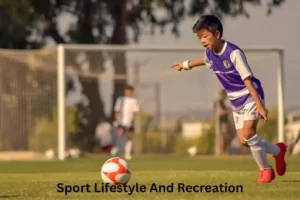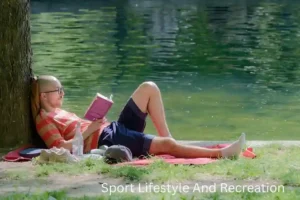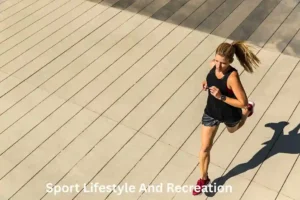Sport Lifestyle And Recreation
Sport, lifestyle, and recreation are more than activities — they shape how we live and feel. They bring energy to the body, clarity to the mind, and joy to the heart. Whether it’s the discipline of sport, the habits of a healthy lifestyle, or the refreshment of recreation, each adds value to life. Together, they create balance, purpose, and connection. This article explores how these three elements work in harmony to improve well-being and inspire a better way of living.

Understanding the Interplay of Sport, Lifestyle, and Recreation
Sport, lifestyle, and recreation are deeply connected, yet each plays a unique role in shaping a fulfilling life. Sport is not only about competition or physical performance; it teaches discipline, teamwork, and resilience. It pushes individuals to set goals, overcome challenges, and celebrate progress. Through sport, people often discover their strengths, develop social bonds, and learn how to adapt under pressure.
Lifestyle refers to the everyday choices that influence our health, mindset, and overall quality of life. These choices include diet, sleep patterns, work-life balance, and how we manage stress. A lifestyle built on healthy habits creates the foundation for both physical and mental well-being. When sport is part of this lifestyle, it adds structure and motivation, helping people stay active and engaged.
Recreation, on the other hand, is about refreshment and renewal. It can be as simple as a nature walk, a hobby, or playing a casual game with friends. Unlike competitive sports, recreation focuses on enjoyment rather than achievement. It allows the mind and body to recover, sparking creativity and reducing stress.
When sport, lifestyle, and recreation work together, they form a balanced approach to living. Sport strengthens the body and mind, lifestyle sustains healthy habits, and recreation restores energy and joy. This combination not only improves personal well-being but also builds stronger communities by bringing people together in shared experiences.
Sports as a Path to Growth, Health, and Self-Discovery
Sports have always been a powerful catalyst for personal growth. They challenge individuals to step outside their comfort zones, set measurable goals, and commit to consistent effort. Whether it’s a team sport like football or a solo pursuit like running, the discipline required builds resilience, patience, and perseverance. Every practice session, every game, and every setback becomes an opportunity to learn — not just about the sport itself, but about one’s own strengths and weaknesses.
From a health perspective, sports are one of the most effective ways to maintain physical fitness. Regular participation improves cardiovascular health, strengthens muscles and bones, and enhances flexibility and coordination. Beyond the physical benefits, sports have a significant impact on mental health. Physical activity triggers the release of endorphins, reducing stress and elevating mood. The focus and strategic thinking required in sports also sharpen cognitive skills, improving decision-making and problem-solving abilities.
Self-discovery often emerges naturally through sports. Competitive moments reveal how a person reacts under pressure, while training teaches the value of consistency and preparation. Team sports encourage empathy, communication, and leadership, while individual sports cultivate self-reliance and accountability. In both cases, sports help people understand their values — whether that’s determination, fairness, or the joy of shared success.
Ultimately, sports are more than a physical activity; they are a life-shaping experience. They teach lessons that extend far beyond the field or court, influencing how we approach challenges in school, work, and personal relationships. For many, sports become a lifelong source of motivation, health, and self-discovery.

lifestyle Choices that Promote Mindfulness and Vitality
A healthy lifestyle is built on intentional choices that nurture both body and mind. It’s not just about following routines but about creating habits that support long-term well-being. Balanced nutrition, quality sleep, regular physical activity, and effective stress management form the pillars of a lifestyle that promotes vitality. When these elements are aligned, they create a natural rhythm that fuels energy, focus, and emotional stability.
Mindfulness is a key component of a truly healthy lifestyle. It’s the practice of being fully present in each moment, whether during a morning jog, a family meal, or a quiet meditation session. Mindfulness encourages awareness of how daily habits affect mood, health, and productivity. For example, recognizing how a good night’s sleep impacts performance or how a balanced diet boosts energy can motivate healthier decisions.
Physical activity plays an essential role in lifestyle design. It doesn’t have to be intense workouts — activities like yoga, walking, or light cycling can be just as effective when practiced consistently. These movements not only strengthen the body but also refresh the mind, helping to release tension and improve concentration.
Equally important is balancing work and leisure. A lifestyle that prioritizes rest alongside productivity prevents burnout and supports long-term motivation. Small daily rituals — such as stretching in the morning, limiting screen time, or taking breaks to step outdoors — can make a significant difference in maintaining vitality.
In essence, lifestyle choices are the framework within which sports and recreation thrive. When built on mindfulness and healthy habits, this framework ensures that every activity, whether competitive or leisurely, contributes to a fuller, more energized life.
Emotional and Mental Well-Being Through Active Living
Active living — the practice of incorporating regular movement into daily life — is one of the most effective ways to protect and enhance emotional and mental health. Physical activity stimulates the release of endorphins, often called “feel-good” hormones, which help reduce stress, anxiety, and feelings of depression. Even simple activities like walking, cycling, or swimming can have an immediate mood-lifting effect, making them valuable tools for emotional balance.
Engaging in sports or recreational activities also provides a healthy outlet for managing stress. Physical exertion allows the body to release built-up tension, while the focus required during activity shifts attention away from daily worries. For example, concentrating on your breathing during a run or on your technique during a game can create a meditative state, clearing the mind and improving mental clarity.
Active living fosters self-confidence as well. Achieving small physical goals — whether lifting a bit more weight, running a longer distance, or improving a skill — builds a sense of accomplishment. This boost in self-esteem often translates into other areas of life, such as work, relationships, and decision-making.
Social interaction is another key benefit. Participating in group sports, fitness classes, or community recreation activities creates opportunities for connection, support, and friendship. These social bonds are crucial for mental well-being, reducing feelings of isolation and providing a sense of belonging.
Ultimately, active living is more than exercise — it’s a holistic approach to maintaining a positive state of mind. By regularly moving the body, engaging with others, and setting achievable goals, individuals can create a strong foundation for emotional resilience and mental clarity. Over time, this not only improves mood but also enhances the ability to cope with life’s challenges.
Recreation as a Source of Intentional Joy and Balance
Recreation is often mistaken for mere leisure, but it’s much more purposeful than simply passing time. It is the conscious choice to engage in activities that bring enjoyment, relaxation, and renewal. Whether it’s hiking in nature, painting, gardening, playing a casual game of badminton, or even cooking a favorite dish, recreation recharges both the mind and body. By setting aside time for enjoyable pursuits, we create space for mental refreshment and emotional stability.
Unlike competitive sports, recreation is not driven by performance or achievement. Its primary aim is to nurture joy and provide balance in a busy, goal-oriented world. This balance is crucial because constant work, even in pursuit of personal goals, can lead to burnout. Recreational activities act as a counterweight, allowing the brain to shift from problem-solving mode to creative exploration.
Engaging in recreation also promotes physical health, albeit in a gentler way than formal exercise. Activities like swimming, dancing, or walking in a park still boost cardiovascular health, improve flexibility, and enhance coordination — all while being enjoyable. This makes recreation accessible to people of all ages and fitness levels, from children to seniors.
Mentally, recreation sparks creativity and improves mood. When we immerse ourselves in enjoyable, low-pressure activities, the brain produces dopamine, which is linked to motivation and pleasure. This chemical boost can improve focus, inspire fresh ideas, and even make work feel more manageable afterward.
Recreation also strengthens relationships. Shared hobbies or outings with family and friends create positive memories, deepen bonds, and improve communication. In communities, recreational events and facilities encourage people to come together, fostering a sense of belonging.
In essence, recreation is not a luxury but a necessity. It is a deliberate practice of joy that restores energy, prevents burnout, and keeps life in healthy balance. When combined with sport and a healthy lifestyle, it completes the foundation for a truly fulfilling life.

The Link Between Play, Creativity, and Productivity
Play is often seen as something reserved for children, but it is a vital element of a healthy and successful adult life. In its simplest form, play is unstructured activity driven by curiosity, imagination, and enjoyment. It could be a friendly game, a creative hobby, or even lighthearted competition among friends. While it may seem purely recreational, play has a powerful effect on creativity and productivity.
When we engage in playful activities, the brain enters a relaxed yet stimulated state. This combination opens the door to creative thinking, allowing new ideas to emerge without the pressure of deadlines or expectations. For example, someone who spends time playing a musical instrument or solving a puzzle may find themselves approaching work problems with fresh perspectives. This “mental reset” helps break patterns of overthinking and encourages innovative solutions.
Play also fuels productivity by preventing mental fatigue. Constant focus on tasks without breaks can lead to burnout and reduced efficiency. Incorporating moments of play — whether it’s a quick game of table tennis at the office, a short walk with friends, or even engaging in a hobby during lunch breaks — allows the mind to recharge. This renewed energy often results in faster, higher-quality work.
Physically, playful activities often involve movement, which boosts blood flow to the brain and increases alertness. Even short bursts of playful exercise, such as dancing to a favorite song or tossing a ball, can improve mood and motivation for the rest of the day.
Play also enhances teamwork and social bonds. Group games and shared creative activities foster trust, improve communication, and strengthen relationships — all of which are essential for collaborative productivity.
In short, play is not a distraction from important work; it is a catalyst for better thinking, sharper problem-solving, and sustained motivation. By weaving playful moments into daily life, individuals and teams can unlock greater creativity while maintaining high levels of productivity.
Building Stronger Communities Through Shared Activities
Communities thrive when people come together with a shared sense of purpose, enjoyment, and connection — and sport, lifestyle, and recreation provide the perfect avenues for this. Shared activities create opportunities for people of different ages, cultures, and backgrounds to interact, building trust and mutual understanding. Whether it’s a neighborhood sports tournament, a local fitness class, or a weekend hiking group, these gatherings strengthen the social fabric.
Sports, in particular, have a unique power to unite communities. Local teams and events encourage residents to rally together, celebrate successes, and support one another. Even spectators become part of the experience, contributing to a sense of pride and belonging. This collective enthusiasm can transform a simple match or race into a cultural tradition that people look forward to year after year.
Recreational programs also play a vital role in inclusion. Community centers, parks, and public recreational facilities often host activities that welcome everyone, regardless of skill level or physical ability. Such programs help newcomers integrate into the community, reduce social isolation, and provide safe spaces for interaction.
Active lifestyle initiatives further strengthen these bonds. Group fitness challenges, charity walks, or clean-up drives not only improve health but also give participants a shared goal. Working together toward these objectives fosters cooperation and reinforces the idea that everyone has a role to play in the well-being of the community.
Shared activities also promote intergenerational connections. Older adults can mentor younger participants in sports or hobbies, while younger members bring fresh energy and perspectives. These exchanges create a culture of respect, empathy, and continuous learning.
Ultimately, communities built around shared activities are more resilient, supportive, and vibrant. They offer not just a network of acquaintances, but a circle of trust and friendship where people feel valued. In this way, sport, lifestyle, and recreation become more than personal pursuits — they become the foundation for strong, connected communities.
Conclusion
Incorporating sport, lifestyle, and recreation into daily life is a pathway to holistic well-being. Together, they enhance physical health, boost mental clarity, and bring emotional balance, while also fostering creativity, joy, and social connection. By consciously embracing movement, mindful habits, and enjoyable activities, individuals can lead a life full of energy, purpose, and fulfillment. Ultimately, these practices remind us that a truly vibrant life is built not just on achievement, but on balance, connection, and intentional living.